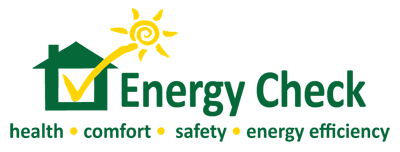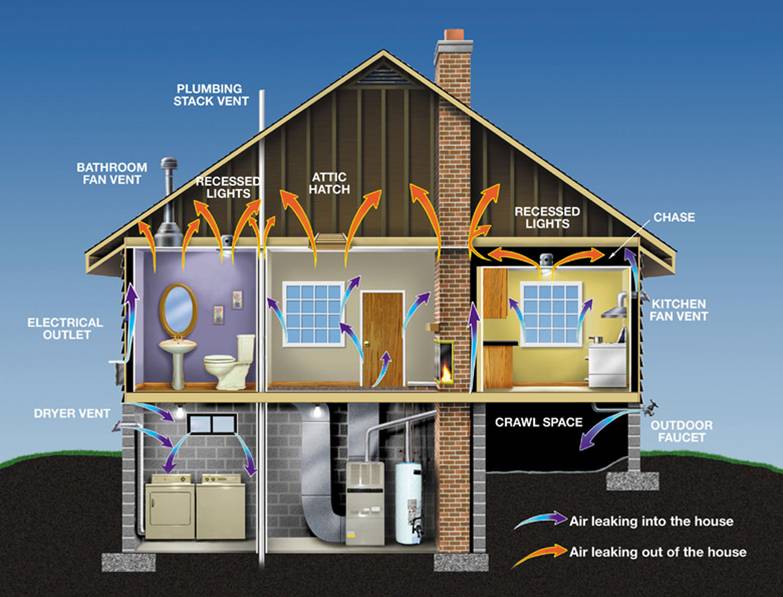Benefits of an Energy Audit
An Energy Audit gives you crucial information about your biggest investment and the space in which you and your family live, breathe, and grow. The information from a certified auditor can alert you of any health or maintenance concerns and give you the solutions you need to make your home the best it can be. Simply put, it gets you on a path to saving money and energy monthly for as long as you live in in your home while improving health and safety of your family, and durability and efficiency of the building.
What is an Energy Audit?
An energy audit is an in-depth examination of your home to determine
- Where and how energy is being used
- Which systems are operating inefficiently
- What kind of cost effective measures can be put in place to make your home healthier, more comfortable, more affordable and energy efficient.
The initial Home Energy Audit visit may take from 3 – 5 hours. You will receive a lengthy diagnostic rich inspection of your home and a full report of our findings, recommendations and, if you like, an estimate for the work being recommended.
Video on the energy audit process
Link to an infographic on the Energy Audit process.
Our Whole House Approach
The Energy Check home performance approach diagnoses areas for potential improvement based on how all the components of the home work together. This approach focuses on your needs and is more likely to get to the root of a comfort issues while at the same time increasing the efficiency of the home. Our process also gives homeowners peace of mind that their home is as safe and healthy as possible before and after completion of a retrofit project. Proper project design followed up with quality assurance testing work to keep your family and your home safe, comfortable and efficient.
Interior and Exterior Physical Inspection
How it Works: Protect your biggest investment – your home. Our close inspection of the building will uncover general maintenance issues as well as the potentiality of any major durability issues. We evaluate your home’s structural integrity, and give you estimates of the useful life expectancy for major systems.
Standards: We comply with the IRC and IECC building codes, critical for meeting the requirements of the local building officials.
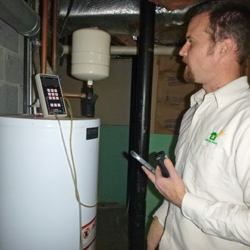
Blower Door Test
How it Works: The Blower Door fan is temporarily sealed into an exterior doorway and is used to remove air from the building, which creates a small pressure difference between inside and outside. This pressure difference forces air through all holes and penetrations in the building envelope. Simultaneously, we use an Infrared Scanner to allow us to “look inside your walls”, pinpointing sources of air and moisture, as well as inadequacies
Standards: The American Society of Heating, Refrigerating and Air Conditioning Engineers (ASHRAE) recommends, for energy efficiency as well as occupant health, that the house have a tightness of .35 ACH (Air Changes per Hour) or less and that intentional, mechanical fresh air ventilation be added in order for the house to provide healthy air. Further, for a home at .25 ACH or less, mechanical fresh air is mandatory by ASHRAE standards. We are also IECC building code compliant in this area.
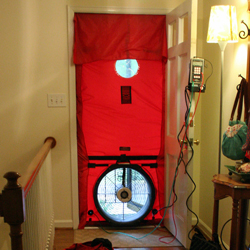
Infrared Imaging
How It Works: Infrared scanning is utilized to detect thermal defects and air leakage in building envelopes. The infrared imaging measures surface temperatures using an infrared camera that detects light in the heat spectrum. Infrared images record the temperature variations that help the auditor determine whether insulation levels and installation are adequate. The infrared camera is also a great tool to identify air leakage. The blower door exaggerates air leaking through defects in the building envelope and the infrared camera detects those leaks as dark streaks in the image.
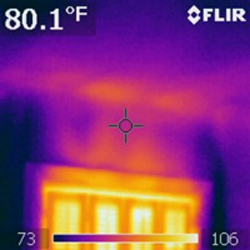
Duct Pressure Testing
How It Works: With the blower door in place, we are able to test your ducts to determine how conditioned air is being lost through the duct work before it reaches its intended destination. Each cubic foot of air that leaks out of the duct system must be made up by a cubic foot of air blown in by the fan. We can quantify the duct leakage at the test pressure by measuring the the amount of air moving through the fan.
Standards: For duct leakage testing, the standard pressure used is 25 Pascals, which is close to the operating pressure of a typical duct system. This means that when we measure, say, 120 cubic feet per minute of duct leakage at 25 Pascals (written 120 cfm25), that number is a pretty good estimate of how much air leaks out of the duct system while it’s operating.
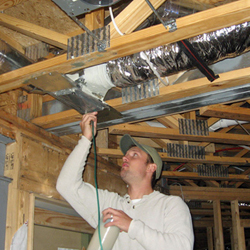
Moisture Content (MC) Testing
How it Works: Moisture Content (MC) testing is used as an indicator of moisture intrusion or water damage in materials, as elevated MC can result in microbial (mold) growth and decay (rot). Useful for most materials, MC is a measure originally derived from how much water is in a piece of wood relative to the weight of the wood itself. MC is expressed as a percentage and is calculated by dividing the weight of water in the wood by the weight of that wood if it were oven dry.
Standards: An MC reading of 16% is well‐recognized as the limit for surface mold. The Federal Emergency Management Agency recommends 15% moisture content as a minimum standard for drying and remediation of flood‐damaged buildings.
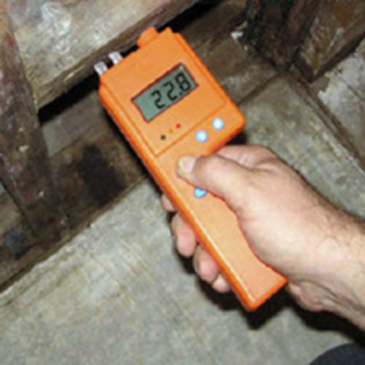
Relative Humidity (RH) Testing
How it Works: A Hygrometer measures humidity as a percentage of Relative Humidity (RH); an indication of the amount of moisture in the air, relative to the maximum amount the air can hold at that temperature. You, your family, pets and even your indoor plants produce moisture. We also add water vapor to indoor air through routine household activities: cooking, showering, bathing, doing laundry, and dishwashing. More moisture can enter your home through a basement and/or crawlspace.
Standards: The American Lung Association, American Medical Association, and the EPA recommend maintaining relative humidity level in the 30% ‐ 50% range.
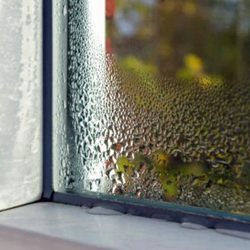
Ambient Carbon Monoxide Testing
How it Works: Carbon monoxide (CO) is a colorless, odorless, poisonous gas that can kill you depending on the concentration. CO poisoning is usually caused by combustion in poorly ventilated enclosures. The symptoms of CO poisoning are very flu‐like (headache, nausea, shortness of breath, dizziness and confusion), and are usually not recognized. CO gas is produced when fossil fuel burns incompletely because of insufficient oxygen. During incomplete combustion, the carbon and hydrogen combine to form carbon dioxide, water, heat, and carbon monoxide.
Standards: Safe concentration levels are 0 (zero), the hazard increases dramatically above 30 Parts Per Million (PPM). Based on BPI Standards, if ambient levels of CO exceed 35 PPM, all gas appliances must be turned off, the space ventilated and evacuated.
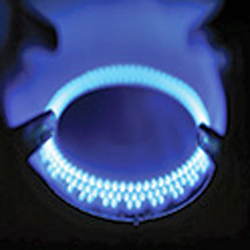
Gas Leak Testing
How it Works: Since natural gas & propane are odorless and colorless in their natural form, a distinctive odorant called mercaptan is added to help you detect a gas leak. Mercaptan makes the gas smell like sulfur or “rotten eggs”. If you smell gas, immediately evacuation the building without doing anything that could create a spark such as operating a light switch or telephone. From a safe location, call your gas company’s emergency line. Call 911 if you believe the situation is
dangerous.
Standards: If a gas leak is detected within the building, Energy Check is required to flag the exact location of the leak, turn off your main gas line and immediately direct you to call your gas company’s emergency operator for prompt repair.
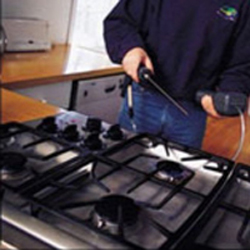
Incentives
REFERRAL PROGRAM
We appreciate that many of our new clients are referred by existing clients. So, please spread the word about your experience with Energy Check. We enjoy this opportunity to express our gratitude for your business and referrals.
When a new customer indicates that you sent them our way,
we will send you a $20 Downtown Blacksburg Gift Certificate
(or a $20 Gas Card if you live outside of the Blacksburg area)
TAX INCENTIVES
Virginia residents can save money on their home’s energy efficient improvements by taking advantage of (1) tax incentives, (2) programs from utility companies, (3) green mortgages, and (4) the Weatherization Assistance Program. As programs change quickly, Virginia residents should use the Database of State Incentives for Renewables and Efficiency to view a complete list of incentives and rebates in their area. Additionally, residents can check their city, county, state, and utility websites for a list of energy efficient programs. – courtesy Building Performance Institute, Inc.
RESOURCES
*NEW* The Inflation Reduction Act of 2022
The Inflation Reduction Act of 2022 is the most significant climate legislation in U.S. history, offering funding, programs, and incentives to accelerate the transition to a clean energy economy. See below for links for further information and tax incentives.
The Inflation Reduction Act | US EPA
Credits and Deductions Under the Inflation Reduction Act of 2022 | Internal Revenue Service (irs.gov)
Building Performance Institute, Inc. (BPI)
Rebates and Incentives: Virginia | Building Performance Institute, Inc. (bpihomeowner.org)
Virginia Energy Sense
Incentives – VES (virginiaenergysense.org)
Energy Star
2022 Tax Credit Information | ENERGY STAR
Renewable Energy Tax Credits | ENERGY STAR
Ready to start? Contact us now!
